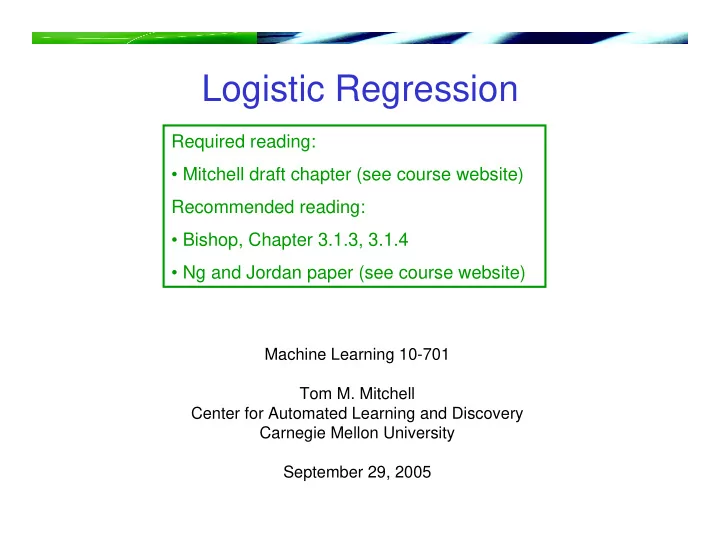

Logistic Regression Required reading: • Mitchell draft chapter (see course website) Recommended reading: • Bishop, Chapter 3.1.3, 3.1.4 • Ng and Jordan paper (see course website) Machine Learning 10-701 Tom M. Mitchell Center for Automated Learning and Discovery Carnegie Mellon University September 29, 2005
Naïve Bayes: What you should know • Designing classifiers based on Bayes rule • Conditional independence – What it is – Why it’s important • Naïve Bayes assumption and its consequences – Which (and how many) parameters must be estimated under different generative models (different forms for P(X|Y) ) • How to train Naïve Bayes classifiers – MLE and MAP estimates – with discrete and/or continuous inputs
Generative vs. Discriminative Classifiers Wish to learn f: X � Y, or P(Y|X) Generative classifiers (e.g., Naïve Bayes): • Assume some functional form for P(X|Y), P(Y) • This is the ‘ generative ’ model • Estimate parameters of P(X|Y), P(Y) directly from training data • Use Bayes rule to calculate P(Y|X= x i ) Discriminative classifiers: • Assume some functional form for P(Y|X) • This is the ‘ discriminative ’ model • Estimate parameters of P(Y|X) directly from training data
• Consider learning f: X � Y, where • X is a vector of real-valued features, < X 1 … X n > • Y is boolean • We could use a Gaussian Naïve Bayes classifier • assume all X i are conditionally independent given Y • model P(X i | Y = y k ) as Gaussian N( μ ik , σ ) • model P(Y) as Bernoulli ( π ) • What does that imply about the form of P(Y|X)?
• Consider learning f: X � Y, where • X is a vector of real-valued features, < X 1 … X n > • Y is boolean • assume all X i are conditionally independent given Y • model P(X i | Y = y k ) as Gaussian N( μ ik , σ i ) • model P(Y) as Bernoulli ( π ) • What does that imply about the form of P(Y|X)?
Very convenient! implies implies linear classification rule! implies
Derive form for P(Y|X) for continuous X i
Very convenient! implies implies linear classification rule! implies
Logistic function
Logistic regression more generally • Logistic regression in more general case, where Y ∈ {Y 1 ... Y R } : learn R-1 sets of weights for k<R for k=R
Training Logistic Regression: MCLE • Choose parameters W=<w 0 , ... w n > to maximize conditional likelihood of training data where • Training data D = • Data likelihood = • Data conditional likelihood =
Expressing Conditional Log Likelihood
Maximizing Conditional Log Likelihood Good news: l(W) is concave function of W Bad news: no closed-form solution to maximize l(W)
Maximize Conditional Log Likelihood: Gradient Ascent Gradient ascent algorithm: iterate until change < ε For all i , repeat
That’s all M(C)LE. How about MAP? • One common approach is to define priors on W – Normal distribution, zero mean, identity covariance • Helps avoid very large weights and overfitting • MAP estimate
MLE vs MAP • Maximum conditional likelihood estimate • Maximum a posteriori estimate
Naïve Bayes vs. Logistic Regression [Ng & Jordan, 2002] • Generative and Discriminative classifiers • Asymptotic comparison (# training examples � infinity) • when model correct • when model incorrect • Non-asymptotic analysis • convergence rate of parameter estimates • convergence rate of expected error • Experimental results
Naïve Bayes vs Logistic Regression Consider Y and X i boolean, X=<X 1 ... X n > Number of parameters: • NB: 2n +1 • LR: n+1 Estimation method: • NB parameter estimates are uncoupled • LR parameter estimates are coupled
What is the difference asymptotically? Notation: let denote error of hypothesis learned via algorithm A, from m examples • If assumed naïve Bayes model correct, then • If assumed model incorrect Note assumed discriminative model can be correct even when generative model incorrect, but not vice versa
Rate of covergence: logistic regression Let h Dis,m be logistic regression trained on m examples in n dimensions. Then with high probability: Implication: if we want for some constant , it suffices to pick � Convergences to its classifier, in order of n examples (result follows from Vapnik’s structural risk bound, plus fact that VCDim of n dimensional linear separators is n )
Rate of covergence: naïve Bayes Consider first how quickly parameter estimates converge toward their asymptotic values. Then we’ll ask how this influences rate of convergence toward asymptotic classification error.
Rate of covergence: naïve Bayes parameters
from UCI data experiments Some sets
What you should know: • Logistic regression – Functional form follows from Naïve Bayes assumptions – But training procedure picks parameters without the conditional independence assumption – MLE training: pick W to maximize P(Y | X, W) – MAP training: pick W to maximize P(W | X,Y) • ‘regularization’ • Gradient ascent/descent – General approach when closed-form solutions unavailable • Generative vs. Discriminative classifiers – Bias vs. variance tradeoff
Recommend
More recommend